--24r Peugeot 203 (1951-1959)
Hard to believe that there were no prior posts on this model, but I did not see any listed. My first Peugeot 203 was a Petrol Blue model that I purchased from H. Hudson Dobson around 1959. That one was the third variation, having the small rear window, no gas cap, checkered ceiling, and polished wheels. I just received a new arrival Peugeot 203, and this one is of similar vintage, except that it has the checkered ceiling, but cream color painted wheels. According to Jacques' Encyclopedia, if it had a checkered ceiling, it should have come with polished wheels. The color is a very nice metallic blue/green color, but I do not especially care for the looks of this model, with the cream wheels and white tires........those white tires look much better with wheels that are either darker in color, or the polished type.
Regards, Terry
hi, i have just got one, its got checkard roof, no cap, and is grey colour with wheels painted the same as the body
I acquired a hard to find metallic green first version of the 24r Peugeot 203 with very nice creamy-yellow ridged hubs. Because I wanted to know more about the background of this model I searched and found interesting information about the development of de Peugeot 203.
The first type of the Peugeot 203, the 'A', is recognizable by the small rear window, the absence of the rear lights on the side flanks, the protruding fuel cap on the right rear fender and out folding direction indicators. The very first models also had 2 handles to open the trunk.
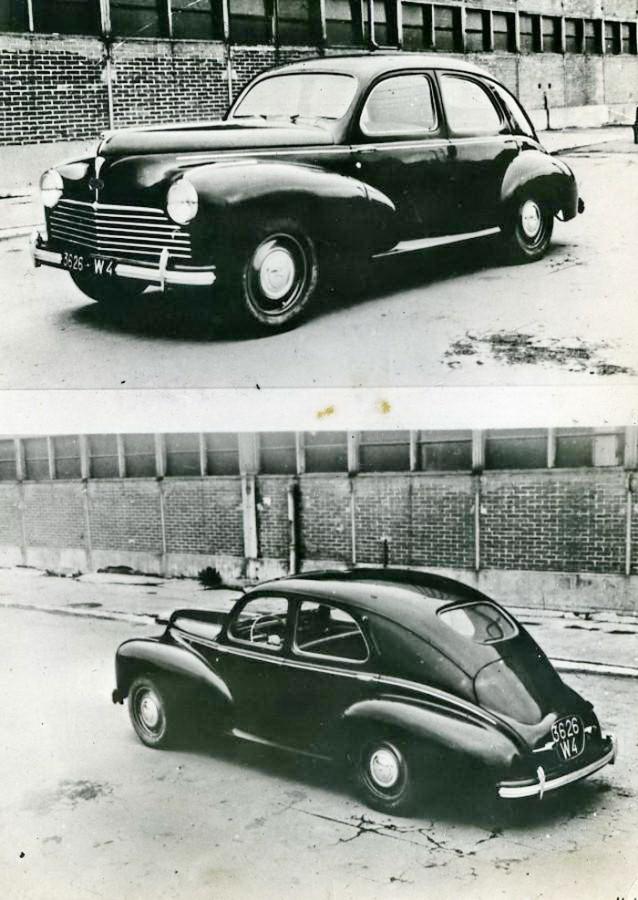
1947 press photo Peugeot 203 in Paris. Note the 2 handles on the back side to open the trunk. It was removed in 1950 when the trunk could be opened from inside the car.
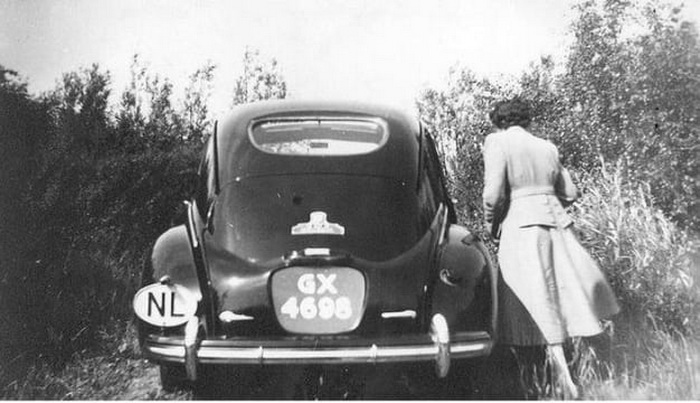
1949 – Rear side of the first issue Peugeot 203 with only 2 tail lights above Dutch provincial registration number on oval license plate - small rear window, protruding fuel cap and 2 handles to open the trunk. No other taillights are visible. Note the open sunroof, visible through the window.
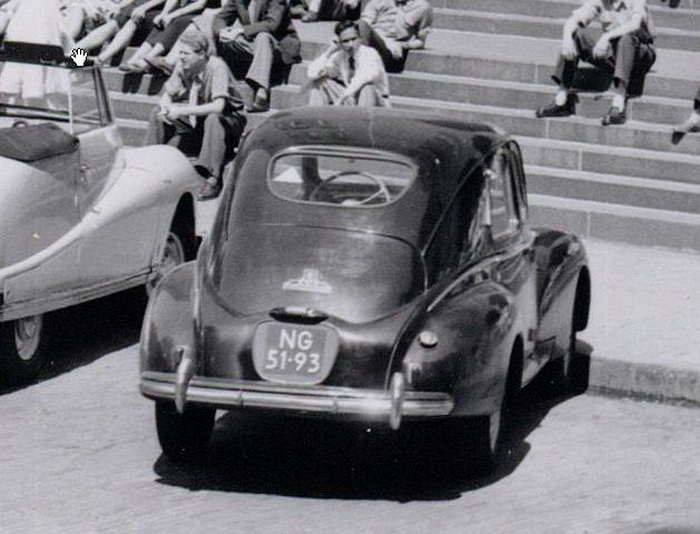
1950 – Rear side of a same slightly later early Peugeot 203 with Dutch national registration number on oval license plate, protruding fuel cap, but without 2 handles to open the trunk which disappeared in 1950.
It needed two extra rear lights on the rear fenders for the Dutch market. Note the beautiful Austin Atlantic convertible on the left side.
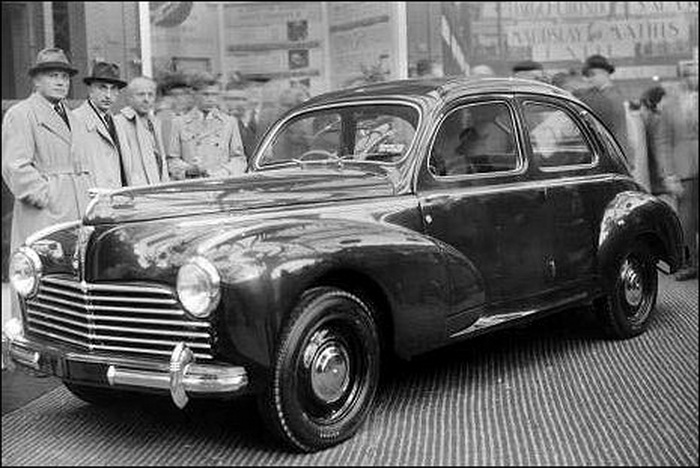
1948 Introduction Peugeot 203 to the public on the Paris Motor Show October 1948.
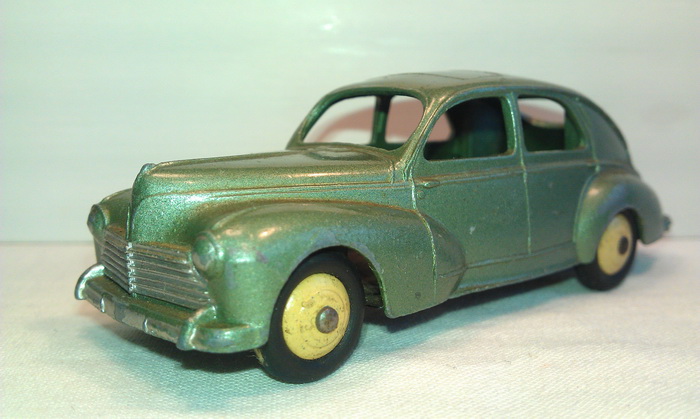
My 24r Peugeot 203 in metallic green with cream-yellow ridged hubs.
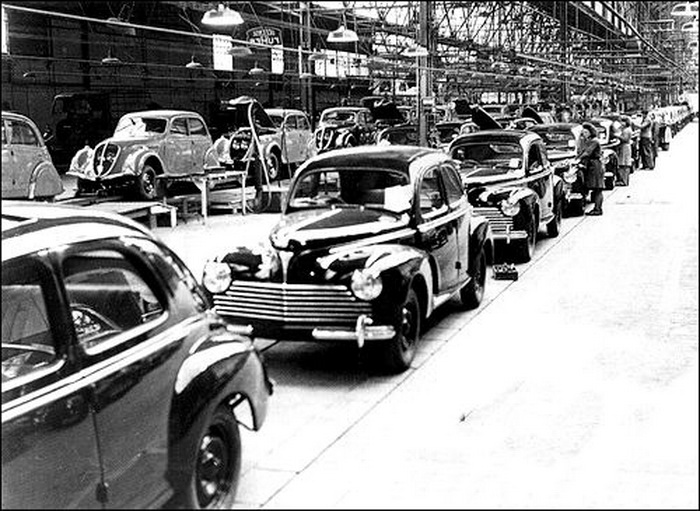
1949 assembly line of the Peugeot 203. It replaced its pre-war model Peugeot 202, here also visible on the left side of the assembly line.
Highlights from Wikipedia and other sources about Peugeot 203:
The Peugeot 203 is the first post-war new model of the French car brand Peugeot. Development of the 203 started secretly as early as 1943. Between 1949, the end of production of the pre-war 202, and 1955, the launch of the 403, it was Peugeot's only model. The first models were presented to the press at the end of 1947 and marketing began at the Paris Motor Show in October 1948, where the Citroën 2CV and Renault 4CV were also exhibited. Volume manufacturing was initially hampered by strikes and shortages of materials, but production got under way late in 1948, with buyers taking delivery of 203s from early 1949.
The 203 was a massive hit in France. In a move which under some conditions might be expected to have encouraged discounting of the predecessor model, the 203 was already depicted and advertised vigorously on the final page of the sales brochure distributed to potential purchasers of the Peugeot 202 in October 1947, nearly a year before the 203 could be offered for sale. There seems to have been a good deal of pent-up demand by the time the 203 was actually launched, and the practicality, price and reliability of the car wooed many motorists. 200 were coming off the production line each day by 1950, and that year the 203 achieved 34,012 domestic sales, commanding 19.5% of the French auto-market, where it was second only to the (far smaller and cheaper) Renault 4CV in terms of unit sales.
Home market success was followed by the export of 203s, notably to West Germany.
The Peugeot 203 has a classic architecture, front engine, rear-wheel drive and independent front wheels. Modernism is more on the engine side, Peugeot has developed an engine with hemispherical explosion chambers and valves in the heads arranged in a V.
Its robust design and its modern engine allowed many preparers to produce sports versions. The most famous is unquestionably the Darl'mat coupe: 2 carburettors, increased compression ratio, modified and lowered body. All these improvements allowed it to reach 140 km/h. Some of these models also have a Constantin compressor to further increase performance.
The 203 had great success in endurance rides. In 1953 Andre Mercier and Charles de Cortanze won a race from Paris to Cape Town (15,000 km) in 17 days, which also underlined the economy of the car: with a full tank you could reach 900 km.
In the same year the Redex race was held in Australia, which was also won. All eleven started cars also arrived, establishing Peugeot's name on this continent.
When production stopped after nearly 12 years of production, 685,825 vehicles had left the Peugeot factories.
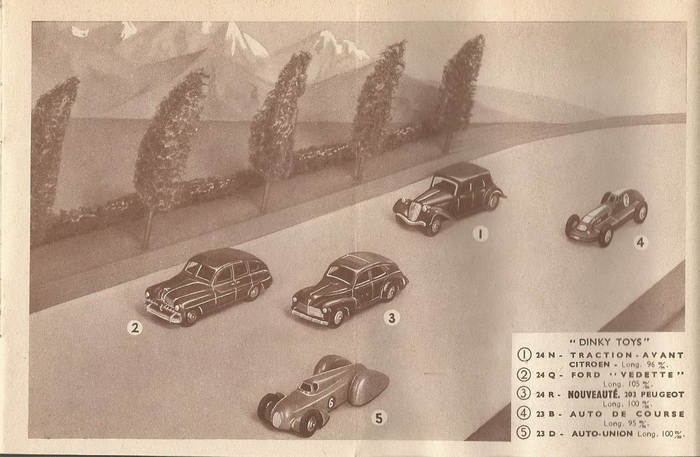
1951 Introduction 24R Peugeot 203 as “Nouveauté“ in French DT catalogue. 24r was for sale in France for the first time in 1952, while it was already for sale in the Netherlands in 1951.
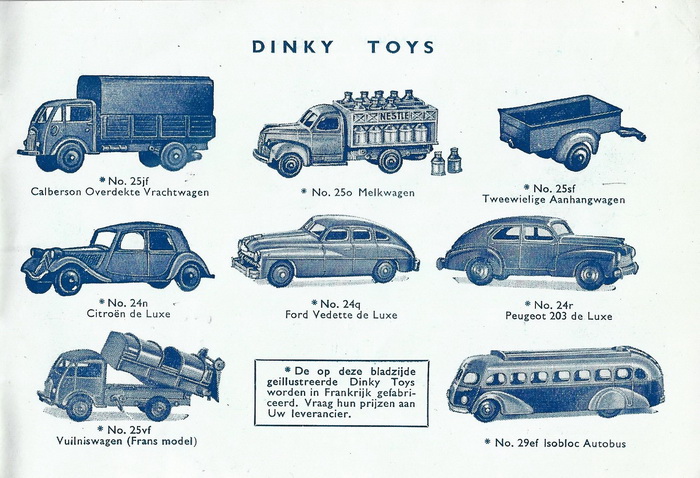
1951 Dutch catalogue with 24r announced as Peugeot 203 de Luxe. After the war, export was also very important for France, just as it was for the United Kingdom.
Given the various sales brochures shown below and technical model information I've found, I think that de prototype of DT Model 24r is of model year 1950, when the 2 handles to open the trunk disappeared.
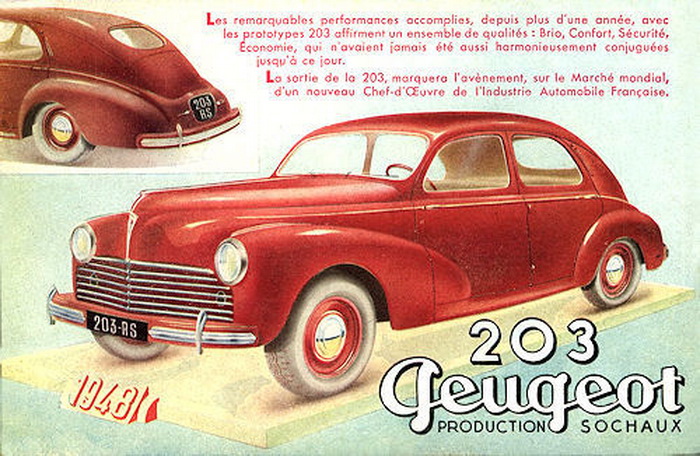
Introduction Peugeot 203 on last page of the 1947 sales brochure Peugeot 202 to announce the arrival of the 203 in advance. The Peugeot 203 was first available from January 1949.
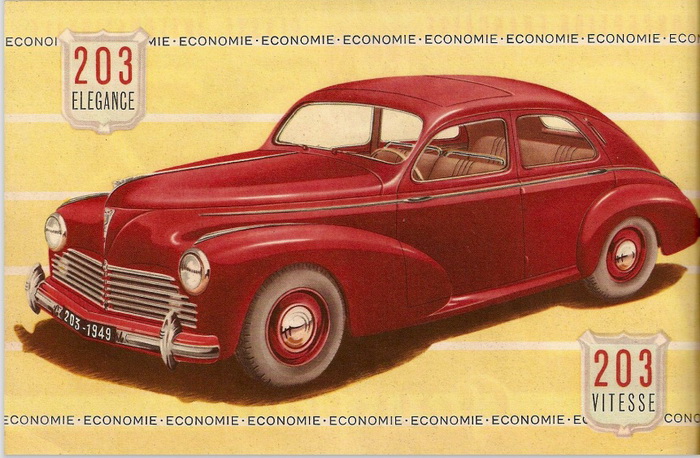
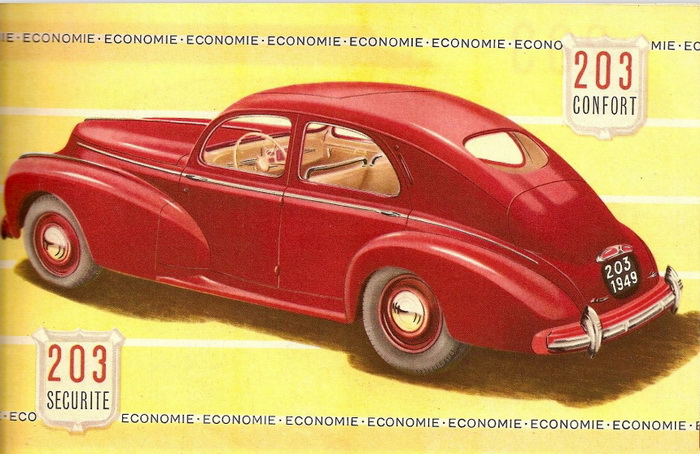
1949 sales brochure Peugeot 203.
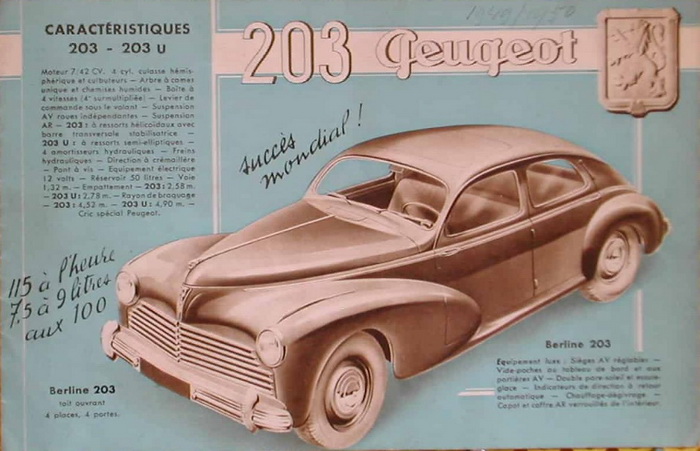
1949/50 sales brochure Peugeot 203.
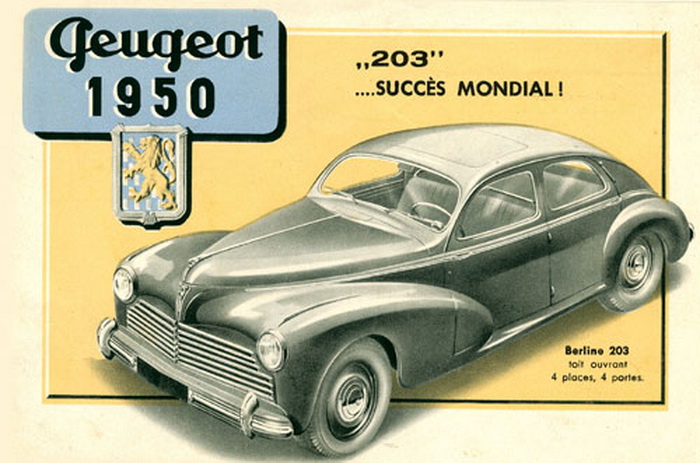
1950 sales brochure Peugeot 203.
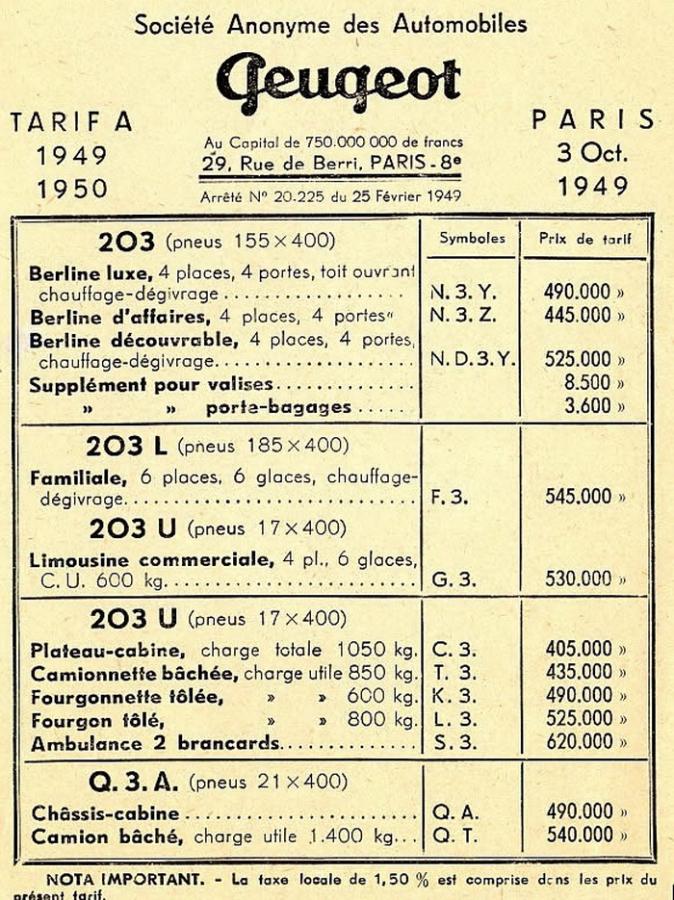
1949/50 Price list Peugeot 203.
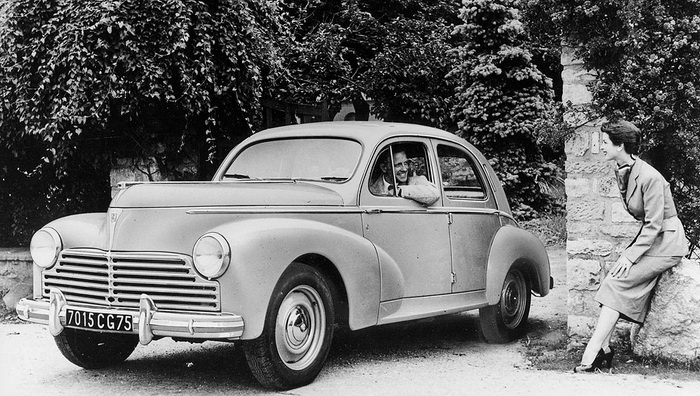
Publication photo Peugeot 203.
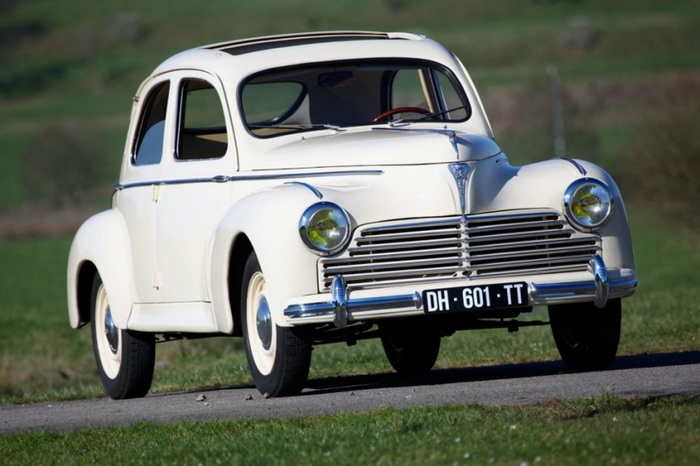
1949/50 neatly restored Peugeot 203 luxury export version in light beige colour.
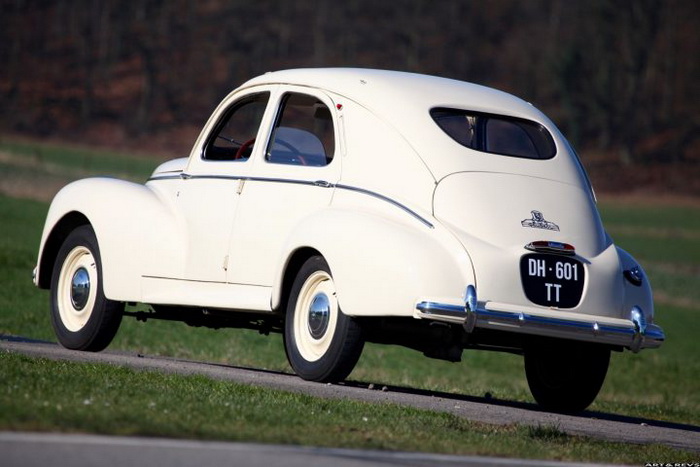
Equipped with small rear window, 2 tail lights above oval license plate, protruding fuel cap and out folding direction indicators.
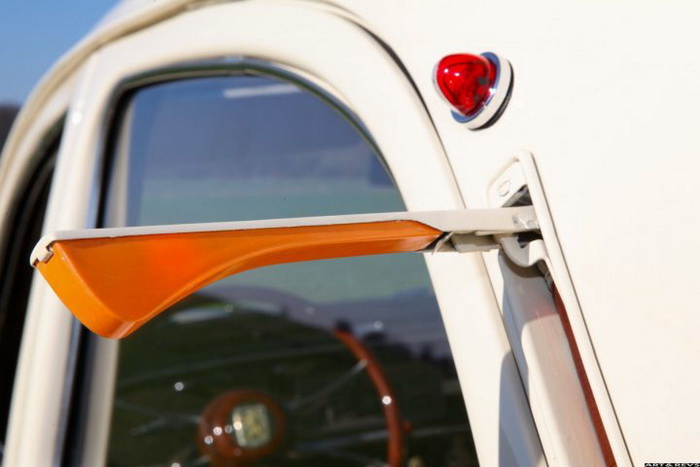
Flip-out direction indicators on the sides with a little light above it. Also visible on DT model 24r. The flip-out direction indicators were removed in 1957.
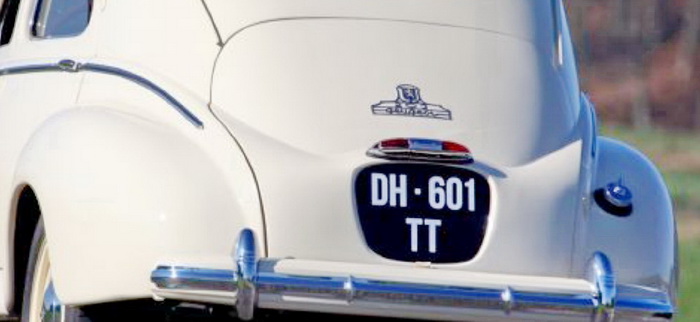
2 tail lights above oval license plate and protruding fuel cap which was recessed in 1953. Also visible on DT 24r.
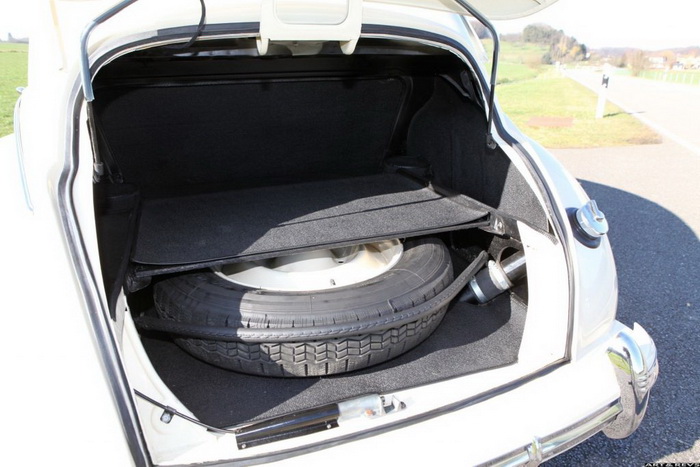
From 1950 the trunk lid can be opened from inside the car. Note the protruding fuel cap which was recessed in 1953. Also visible on DT 24r.
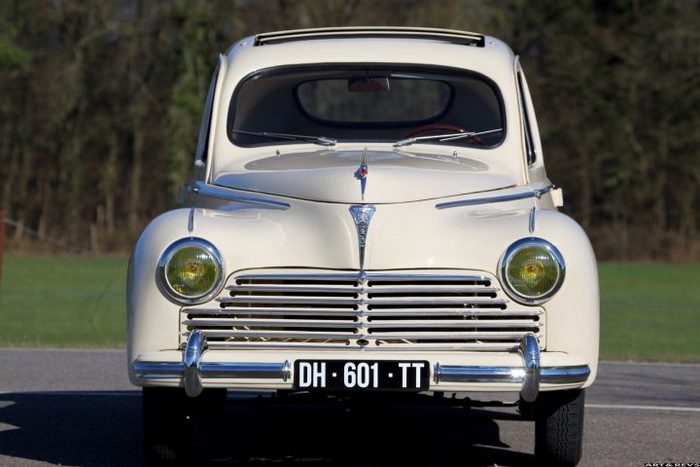
As Jacques's encyclopedia says: The front grille of the real Peugeot 203 has 7 chrome mouldings, while DT 24r has only 6 fitted. Note the hood with the Peugeot ornament on the front. The chrome moldings on the front fenders were removed in May 1950.
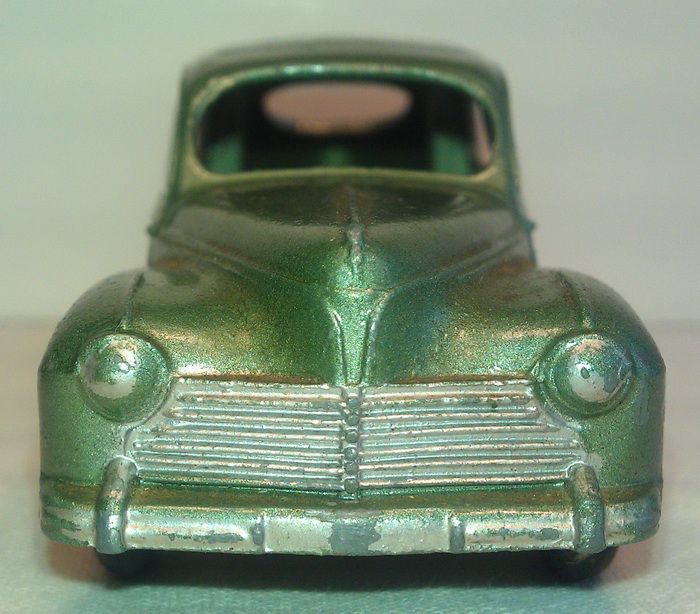
DT 24r with front grille with 6 chrome mouldings instead of 7 as the real one. Peugeot ornament with moldings on hood and moldings on front fenders are clearly visible applied.
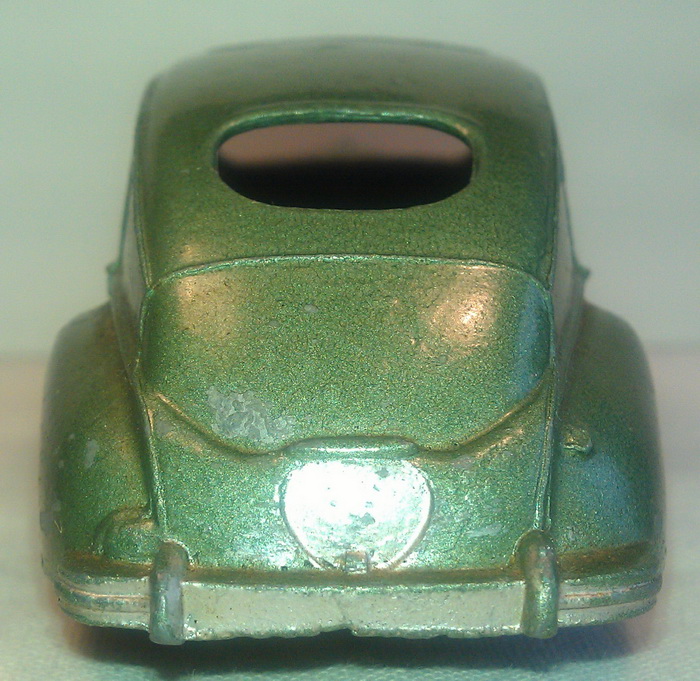
Back side 24r with trunk and oval license plate with tail lights above it, protruding fuel cap and oval small rear window, as the real one above. A "mysterious" bulge on the left side above the bumper, which may represent a brake light?
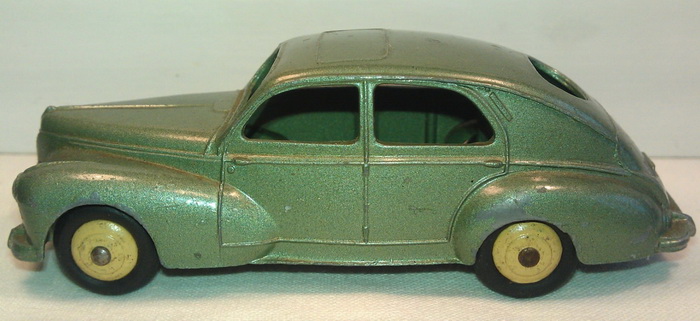
24r left side with out folding direction indicator with a little light above it, door hinges and door handles, also the door key lock are reproduced as the real one. Note the raised contour lines of the doors.
Meccano Bobigny has reproduced the Peugeot 203 in model 24r very well. All features are very well detailed as shown in the pictures above.
The bulge in the left rear fender is somewhat mysterious. Roulet says it "possibly" is a brake light, but I can't find confirmation of that elsewhere. Maybe someone has Wagner's series 24 book that says something about that. I came across information somewhere that the 2 taillights are located above the license plate, of which one taillight also illuminates the license plate and the other taillight is also a brake light.
According to documentation, the 1st issue 24r can be recognized by a small rear window, protruding fuel cap on the right rear fender, inside roof is smooth, ridged hubs sprayed, black M tires, bulge in the left rear fender above the bumper. My 24r has all these characteristics. The 24r Renault 203 is one of the most beloved French Dinky Toys with much colour and casting variants.
The 24r was always sold in a trade box of 6 and has never had an individual box.
Fortunately, Meccano Bobigny choose other colour variants than black, as shown to the public at the 1948 Paris Motor Show. From the pics on the forum it looks like my 24r metallic green with cream yellow ridged hubs is a new colour variant on this forum and I'm very happy with this beautiful scarce colour variant. It is difficult to find a metallic 24r in undamaged condition.
Finally, I'm attaching a photo of the base that hasn't been shown in the forum yet. Strange that the 24r Peugeot 203 base plate never got a sales number as other French Dinky toys cars.
Jan Oldenhuis, 8 October 2022.
Jan--Another wonderful and very complete article on this well known French automobile & the very nice model that Dinky produced. The casting is very true to the real car in all those little details.....great workmanship by those craftsmen. I don't remember seeing that metallic green color before....not very common for sure. I have always found it both interesting and nice that the French Meccano folks used so many metallic finishes in the 1950's, while the English used none. By the way, I don't believe that any of those early post-war French models received a sales number. I think that started with the next round of releases around 1954-1955.
Best regards, Terry
Terry, many thanks for your nice comment.
As you say yourself, Meccano Bobigny has very accurately reproduced the model.
What strikes me about your sublime metallic blue model is that the red light above the outfolding indicators on both sides is also painted red. That is sublimely beautiful extra hand paint work for the ladies of the assembly line. Unfortunately my model did not receive it.
Kind regards, Jan O.
It is always a pleasure to read Jan's articles, this one like all the previous ones is very comprehensive with super photos and plenty of documents.
Of course I have Claude Wagner's book on the 24 series but he did not write any thing about the bulge at the botom of the left hand side wing and none of the many photos in this book show this light. This bulge is suposed to be a stop light it is only on the models cast in the first mould.
What I can remember is that the tiny little lights above the direction indicators were parking lights. Until around 1960 a parking light was to be on at night on cars parked on the streets. I also remember of an estate were cars parked in front of houses were connected by a flex to the mains at night.
I had never thought about it but while studying the casting variations of the 203, it appears that the version with large rear window is not a casting update but a completely new model with a new mould. This is confirmed by the production figure of more than 450 000 models made, this is well over the life span of a mould. The same applies to the traction, over 1 000 000 models made from three different moulds.
All the best.
Jacques
Jacques, thank you very much for your kind compliments and your additional very valuable information. I appreciate that very much
I find it fun and important to find out which prototype a Dinky Toys model could have been made of and especially to show the similarities in a good story with images and documentation.
The choice of the prototype is after all the most important start of the production process for the Dinky Toys model. That should not be missing in the total information about the Dinky Toys model. The making of the Meccano drawing by the draftsman, the tool man who makes the mockup, is all based on the prototype, after which the production process can finally start after approval from the management. Actually, every Dinky Toys collector should also be a fan of the prototype old timers of the Dinky Toys model.
Certainly after the war, both Meccano Liverpool and Bobigny reproduced real existing cars and named them, sometimes complete with model name in the base plate, such as with the 24a Chrysler New Yorker 1955 and the De Soto Diplomat 59. They did this as accurately as possible as can be clearly seen in my contribution about the French 24r Peugeot 203 model. Sometimes adjustments have to be made for technical or cost-saving reasons, as was the case with 27f Estate Car, which has been discussed extensively in the forum. That too is fun to discover and discuss.
Casting variations are also fun to discover and to have, such as the 24r Peugeot 203 with a large rear window.
This change took place on the genuine Peugeot 203 in 1953 and was reproduced in the model by Meccano Bobigny, but not the recessed number plate from oval to rectangular, which took place in 1951. If a new mold has been made for the large rear window, it is a pity that the change of the number plate from oval to rectangular has not been adapted, while the change of the fuel cap has been adapted. Perhaps not adapted for technical or cost-saving reasons, or Meccano Bobigny did not consider the change important enough.
For completeness I attach a photo of a Peugeot garage and Esso service station with a Peugeot 203 and Ford Vedette in front and Esso petrol pumps with signboard, similar to Dinky Toys model 49d.
All the best, Jan O.
Thanks guys, this is the kind of information and discussion I love to see on our website forum! Kind regards, Jan
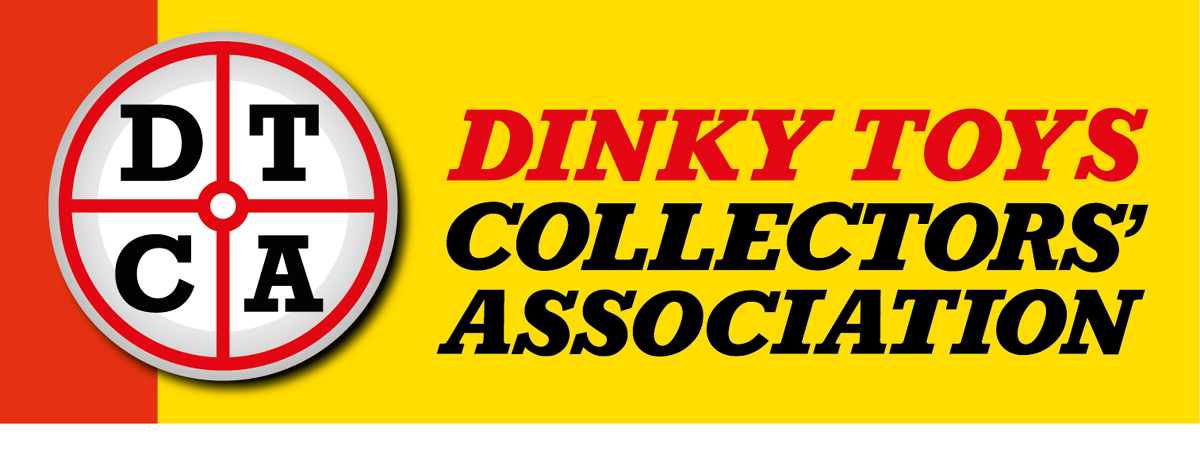


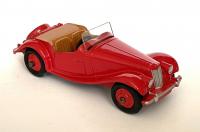
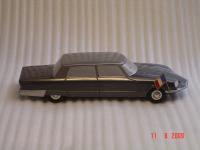
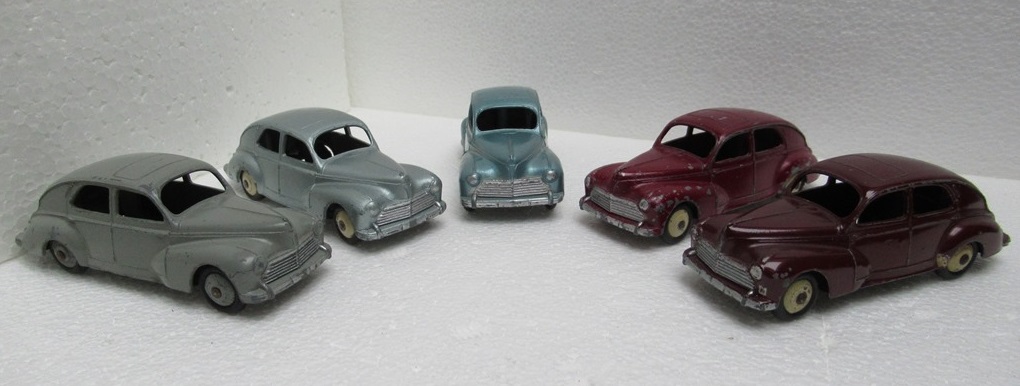
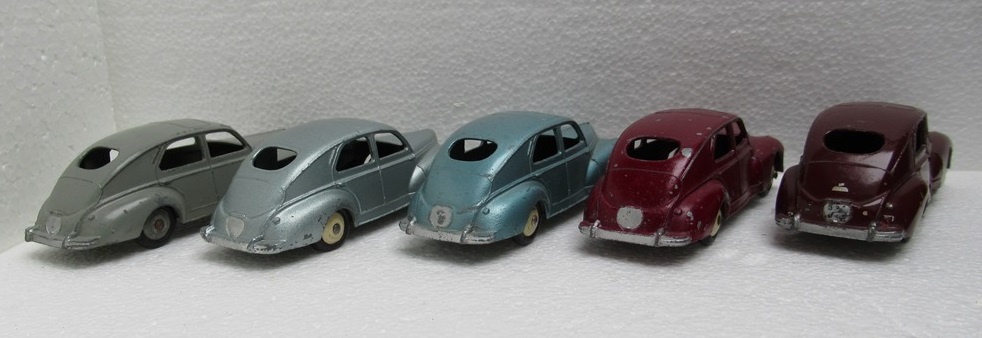
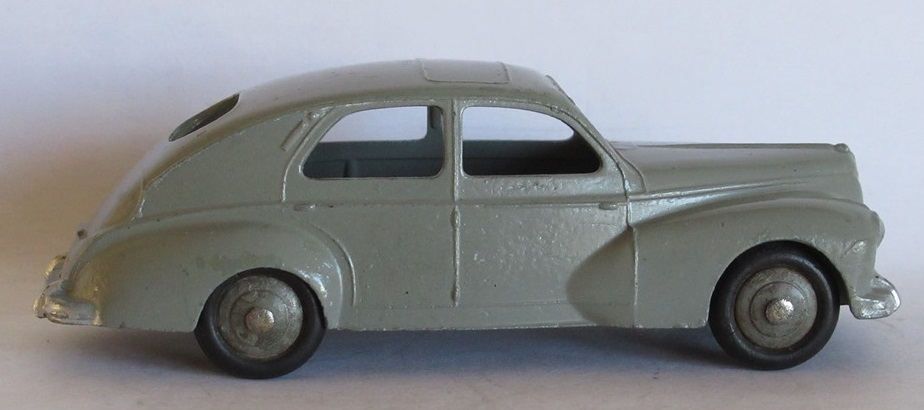
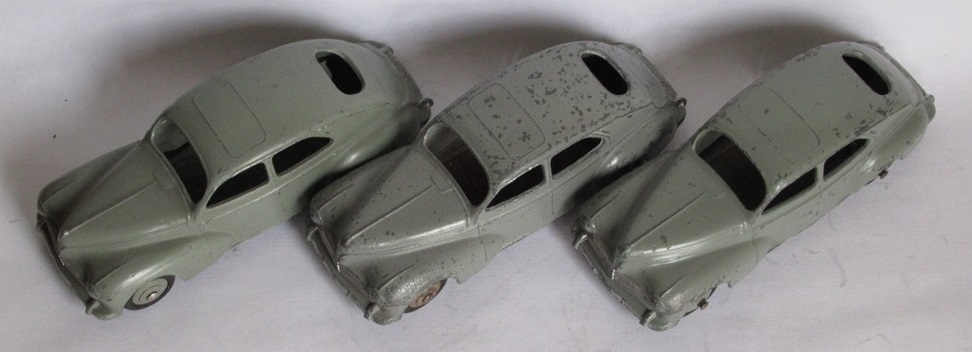


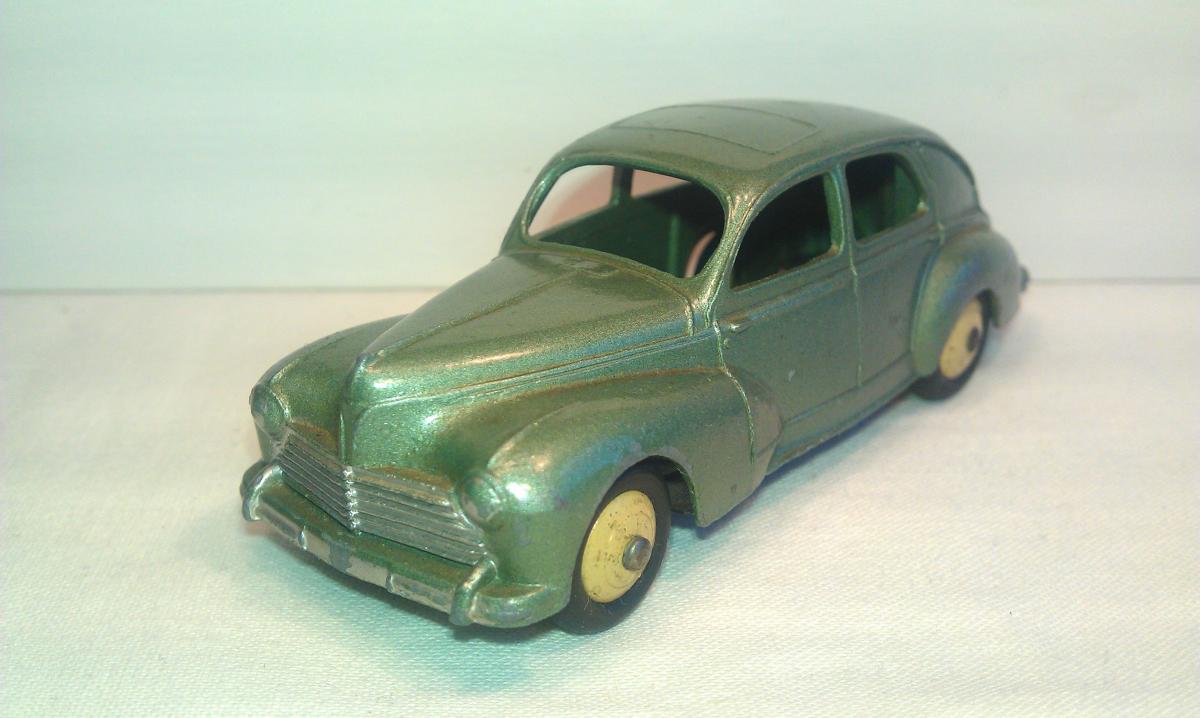
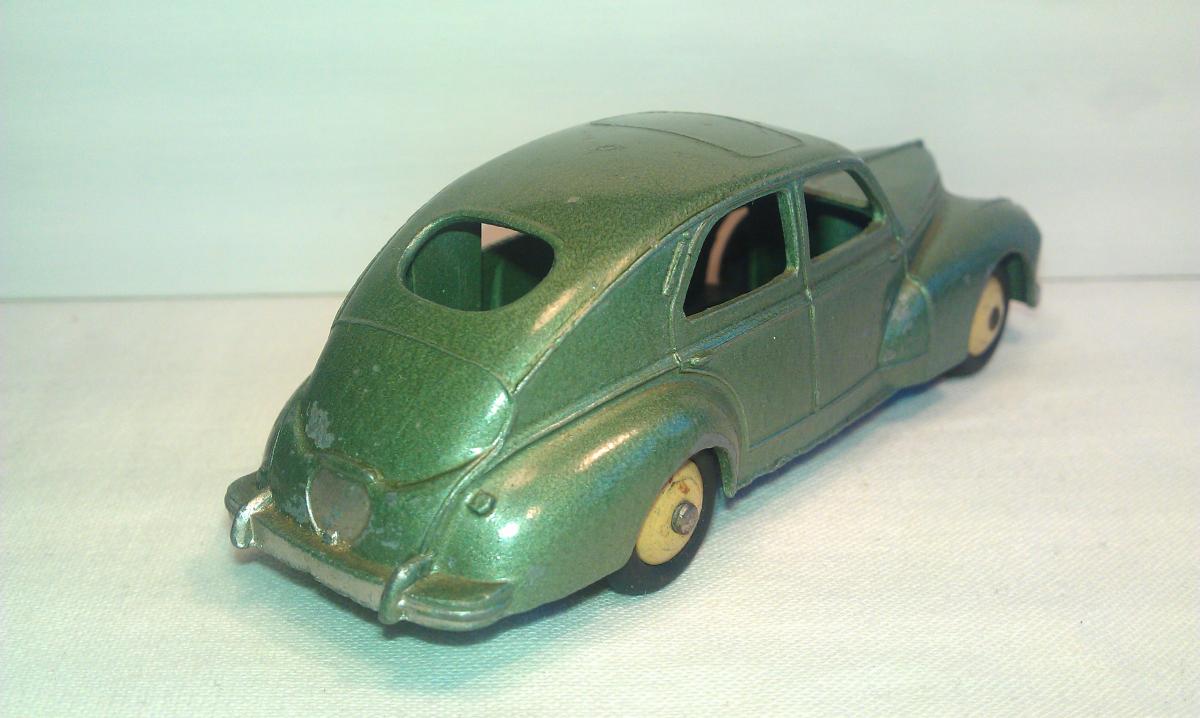
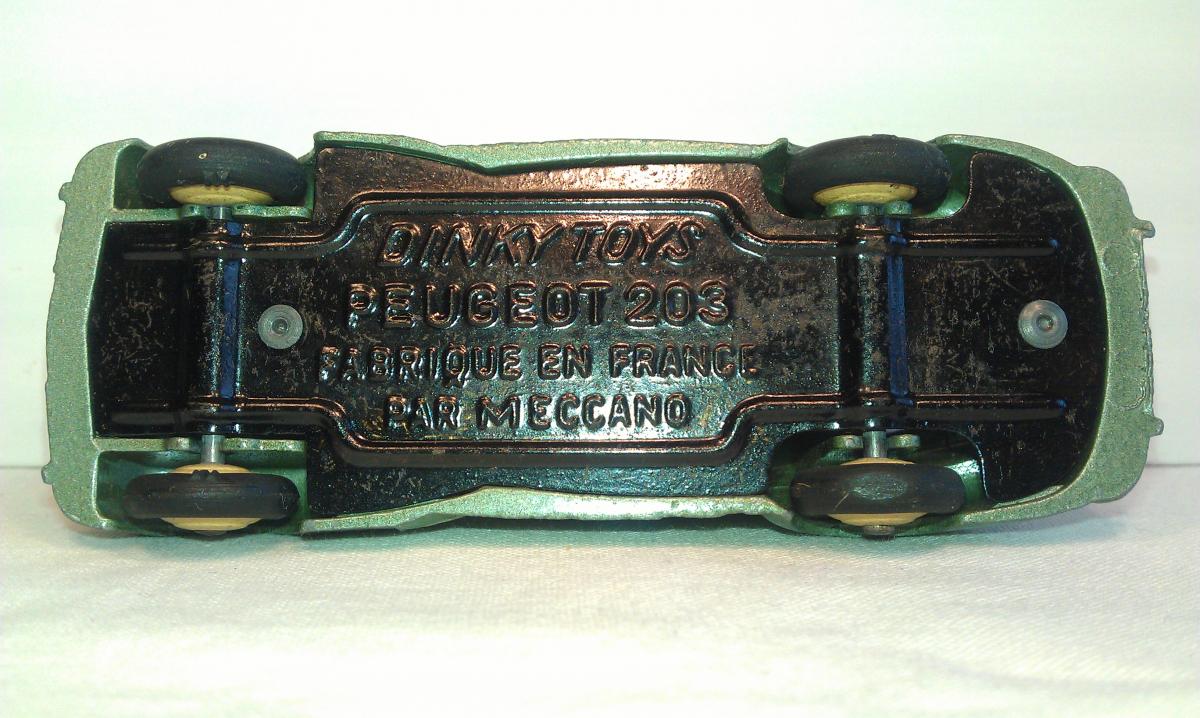


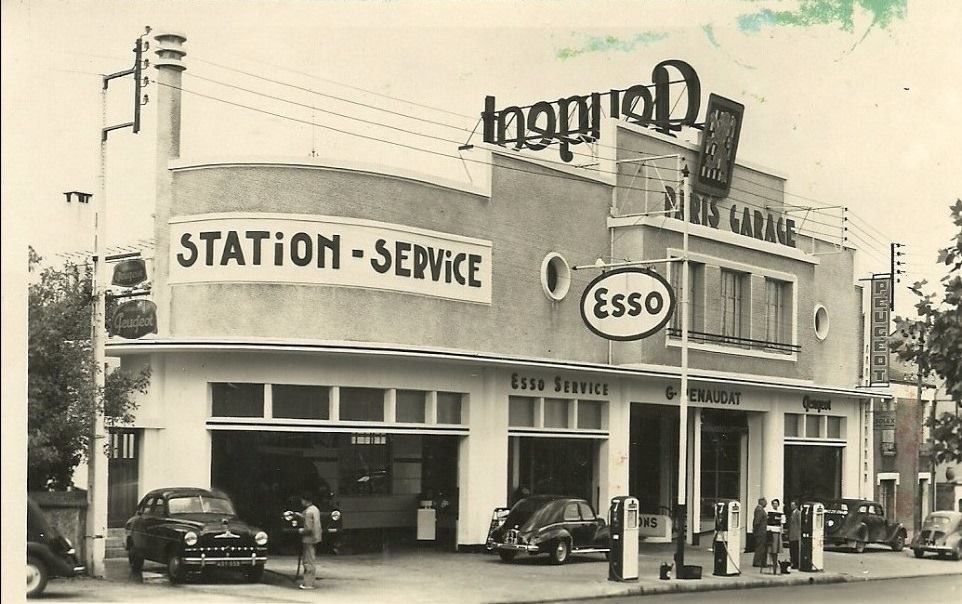
--40h and 254 Austin FX3 Taxi (1952-59)
-066 Bedford Flat Truck (1957-60)
-066 Bedford Flat Truck (1957-60)
--40h and 254 Austin FX3 Taxi (1952-59)
--40h and 254 Austin FX3 Taxi (1952-59)
--40h and 254 Austin FX3 Taxi (1952-59)
--40h and 254 Austin FX3 Taxi (1952-59)
DTCAwebsite upgrade 2023
DTCAwebsite upgrade 2023
--30p and 440 Studebaker Petrol Tanker 'Mobilgas' (1952-61)
--30p and 440 Studebaker Petrol Tanker 'Mobilgas' (1952-61)
--30p and 440 Studebaker Petrol Tanker 'Mobilgas' (1952-61)
DTCAwebsite upgrade 2023
--30p and 440 Studebaker Petrol Tanker 'Mobilgas' (1952-61)
--30p and 440 Studebaker Petrol Tanker 'Mobilgas' (1952-61)
--30p and 440 Studebaker Petrol Tanker 'Mobilgas' (1952-61)
--30p and 440 Studebaker Petrol Tanker 'Mobilgas' (1952-61)
--30p and 440 Studebaker Petrol Tanker 'Mobilgas' (1952-61)
--30p and 440 Studebaker Petrol Tanker 'Mobilgas' (1952-61)
--30p and 440 Studebaker Petrol Tanker 'Mobilgas' (1952-61)
DTCAwebsite upgrade 2023
DTCAwebsite upgrade 2023
DTCAwebsite upgrade 2023
DTCAwebsite upgrade 2023
2024 AGM
2024 AGM
DTCAwebsite upgrade 2023
DTCAwebsite upgrade 2023
DTCAwebsite upgrade 2023
DTCAwebsite upgrade 2023
DTCAwebsite upgrade 2023
DTCAwebsite upgrade 2023
DTCAwebsite upgrade 2023
DTCAwebsite upgrade 2023
DTCAwebsite upgrade 2023